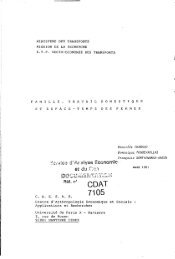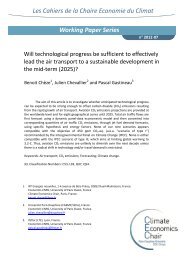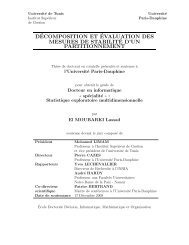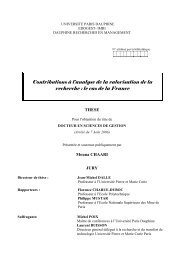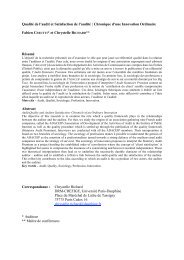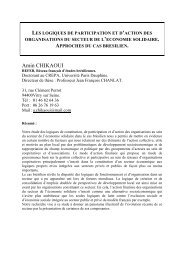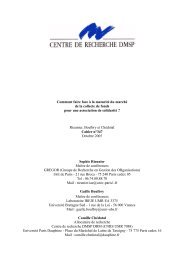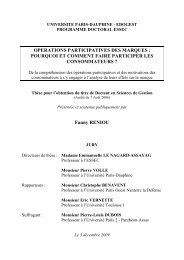TH`ESE Docteur de l'Université Paris-Dauphine Morgan HERVÉ ...
TH`ESE Docteur de l'Université Paris-Dauphine Morgan HERVÉ ...
TH`ESE Docteur de l'Université Paris-Dauphine Morgan HERVÉ ...
You also want an ePaper? Increase the reach of your titles
YUMPU automatically turns print PDFs into web optimized ePapers that Google loves.
climate policy context and then jump into the specifics of the EU ETS:<br />
genesis, trial phase, Kyoto phase and post-Kyoto phase.<br />
1.1.1 Climate change policy context<br />
The Intergovernmental Panel on Climate Change (IPCC), a joint UN-WMO<br />
scientific body, was established in 1988 to evaluate the threat of climate<br />
change. IPCC’s four assessment reports (1990, 1995, 2001 and 2007) established<br />
the need to reduce GHG emissions if humanity is to avoid any strong<br />
adverse impacts of climate change. The conclusions of the latest bodywork<br />
of the IPCC are unequivocal: climate change has already started and its<br />
anthropogenic origin is now wi<strong>de</strong>ly accepted. The international scientific<br />
community is particularly worried about forthcoming manifestations of climate<br />
change.<br />
Adopted in late 1997, the Kyoto Protocol is an international agreement aiming<br />
at fighting global warming. It entered into force in 2005. Simply stated,<br />
the Kyoto Protocol splits the international community into two groups of<br />
countries. On the one hand, there are the so-called ”Annex I countries”<br />
which are the historical emitters of GHGs. These 37 industrialized countries<br />
pledged to an average emissions reduction of six GHGs 1 by 5.2% from<br />
the 1990 baseline year. On the other hand, the ”non-annex I countries”, low<br />
income countries, are not bound by such emissions reduction effort. To facilitate<br />
the emissions reduction process, the Kyoto Protocol has given Annex<br />
Isignatorystatesthree”flexiblemechanisms” to curb their GHGs emissions.<br />
First, international emissions trading is a state-level cap-and-tra<strong>de</strong> mechanism.<br />
The individual state-level emissions reduction objectives (from the<br />
5.2% overall reduction) correspond to capped annual emissions levels in tons<br />
of CO2-equivalent (CO2e). A GHGs emissions rights called an Assigned<br />
Amount Unit (AAU) is assigned to each ton of CO2e. The international<br />
emissions trading allows Annex I countries to tra<strong>de</strong> AAUs among them.<br />
Countries engage in trading so that emissions reductions are first achieved<br />
in countries where the cost of abatement are the lowest. Therefore, emitting<br />
countries for whom it is less costly to achieve emissions reduction would curb<br />
emissions beyond their cap, and tra<strong>de</strong> the thereby obtained excess AAUs<br />
with countries where it is more expensive to reduce GHG emissions. Likewise,<br />
countries for whom it is expected to be expensive to reduce emissions<br />
would resort to this flexibility mechanism to reduce the cost of achieving<br />
their Kyoto target.<br />
Second, the clean <strong>de</strong>velopment mechanism (CDM) is an offset mech-<br />
1 Carbon dioxi<strong>de</strong> (CO2), methane (CH4), nitrous oxi<strong>de</strong> (N2O), sulphur hexafluori<strong>de</strong><br />
(SF6), hydrofluorocarbons (HFCs) and perfluorocarbons (PFCs).<br />
8



